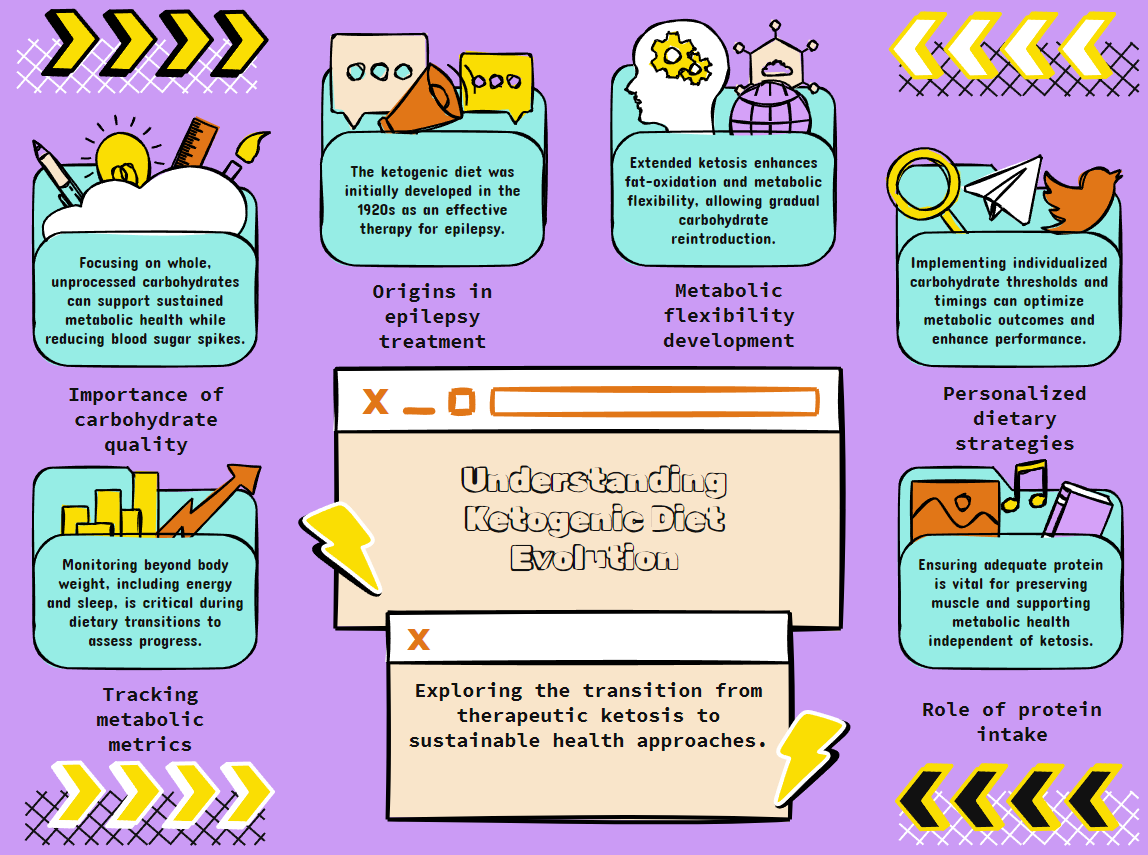
Keto Beyond Therapy
Keto Beyond Therapy
Ketones fuel transformation. Bodies adapt. Metabolism finds balance.
The ketogenic diet has traveled a remarkable path from clinical therapy to mainstream health strategy. Developed initially as a medical intervention for epilepsy in the 1920s, this high-fat, low-carbohydrate approach has evolved substantially. What began as a strict therapeutic protocol has matured into a nuanced framework for metabolic health that extends far beyond its clinical origins.
This evolution reflects our deepening understanding of metabolic function and the growing recognition that dietary approaches must transition from intervention to sustainable practice. The science now points toward a more sophisticated implementation of ketogenic principles that honors both therapeutic efficacy and long-term viability.
The Therapeutic Foundation
Therapeutic ketogenic protocols emerged from careful clinical observation. Physicians at Johns Hopkins Medical Center documented remarkable reductions in seizure activity when patients maintained elevated blood ketone levels through strict carbohydrate restriction. This therapeutic application required precise macronutrient ratios, typically 4:1 or 3:1 (fat to protein and carbohydrate combined), creating a metabolic environment that fundamentally altered brain function and neurological activity.
The clinical ketogenic approach serves as a powerful medicine. It induces profound metabolic changes beyond neurological benefits, including improved insulin sensitivity, reduced inflammation, and enhanced mitochondrial function. These therapeutic effects establish the foundation for understanding ketosis as a metabolic intervention with broad applications.
However, the therapeutic protocol presents significant challenges for sustained implementation. The strict macronutrient ratios, limited food variety, and social constraints make long-term adherence difficult outside clinical settings. This reality necessitates an evolution in approach for those seeking to maintain metabolic benefits without the constraints of therapeutic protocols.
The Metabolic Transition
Transitioning from therapeutic ketosis to a maintenance phase requires understanding the biological adaptations that occur during extended metabolic flexibility. After initial adaptation, the body develops enhanced fat-oxidation capacity, improved mitochondrial function, and greater metabolic flexibility. These adaptations permit a more nuanced approach to carbohydrate intake and macronutrient balance.
Research indicates that once metabolic flexibility is established, many individuals can maintain significant benefits with a modified approach. This maintenance phase typically features:
1. Personalized carbohydrate thresholds based on individual metabolic response
2. Strategic carbohydrate timing around physical activity
3. Emphasis on carbohydrate quality rather than strict quantity
4. Periodic metabolic "reset" through temporary returns to stricter protocols
5. Integration of time-restricted eating patterns
This transition acknowledges that metabolic health exists on a continuum rather than as a binary state. The maintenance phase prioritizes metabolic flexibility over constant ketosis, recognizing that the ability to shift efficiently between fuel sources represents optimal function.
The Science of Sustainability
The sustainability of ketogenic approaches depends on understanding the underlying mechanisms that drive their benefits. Research now suggests that many of the positive outcomes attributed to ketosis stem from multiple factors beyond simply the presence of ketone bodies.
Carbohydrate restriction reduces insulin signaling, which drives numerous beneficial metabolic adaptations. Protein moderation helps maintain appropriate mTOR signaling, influencing cellular growth and autophagy. Increased fat consumption provides essential fatty acids and fat-soluble nutrients while supporting hormonal function. Time-restricted eating patterns enhance circadian rhythm alignment and cellular cleanup processes.
These mechanisms suggest a maintenance approach can preserve key benefits while allowing greater flexibility. The critical insight is that metabolic health stems not from perpetual ketosis but from the metabolic machinery developed during adaptation. This machinery continues functioning efficiently even with strategic carbohydrate incorporation.
Practical Implementation
Implementing a sustainable maintenance phase requires attention to several key principles. First, carbohydrate reintroduction should proceed gradually, with careful attention to individual response. Tracking metrics beyond scale weight, including energy levels, sleep quality, and cognitive function, provides valuable feedback during this transition.
Second, carbohydrate sources matter significantly. Whole-food carbohydrates with fiber, phytonutrients, and minimal processing generally support continued metabolic health. These foods provide valuable micronutrients while minimizing blood glucose volatility.
Third, maintaining adequate protein intake becomes increasingly important during the maintenance phase. Protein supports muscle preservation, immune function, and satiety while providing metabolic benefits independent of ketosis.
Fourth, environmental factors gain prominence during maintenance. Sleep quality, stress management, and physical activity significantly influence metabolic function and can either support or undermine the benefits established during the therapeutic phase.
Finally, periodic metabolic "reset" periods can help maintain metabolic flexibility. These strategic returns to stricter protocols can recalibrate insulin sensitivity and reinforce fat-adaptation machinery.
The Future of Metabolic Health
The evolution of ketogenic approaches reflects a broader shift in nutritional science toward personalization and metabolic optimization. Rather than viewing any dietary approach as universally applicable, we now recognize the importance of individual variation, contextual factors, and adaptive implementation.
This evolution suggests that the future of metabolic health lies not in rigid dietary dogma but in educated self-experimentation guided by objective feedback. Continuous glucose monitoring, ketone testing, and other biometric tools provide unprecedented insight into individual response, allowing for truly personalized implementation.
The most promising direction involves integrating ketogenic principles with other evidence-based approaches, such as time-restricted eating, protein optimization, and strategic carbohydrate timing. This integration acknowledges that metabolic health emerges from multiple overlapping mechanisms rather than a single dietary lever.
Beyond Binary Thinking
The evolution from therapeutic ketosis to the maintenance phase represents a move beyond binary thinking about nutrition. Rather than asking whether someone is "doing keto" or not, we can explore how ketogenic principles might be strategically implemented within a broader nutritional framework.
This nuanced perspective acknowledges that health exists on a continuum, with multiple factors influencing outcomes. It recognizes that the optimal approach varies between individuals and within the same individual across different life contexts and health objectives.
Ultimately, the evolution of ketogenic approaches teaches us something profound about nutrition and health: sustainability requires adaptation. What begins as an intervention must evolve into a lifestyle, guided not by rigid rules but by metabolic awareness and strategic implementation.
The therapeutic power of ketosis provides valuable metabolic machinery. Maintenance involves learning to operate this machinery efficiently across varying conditions. This evolution from therapy to lifestyle represents the true potential of ketogenic principles, offering a path toward metabolic health that extends far beyond temporary intervention into sustainable lifelong practice.
